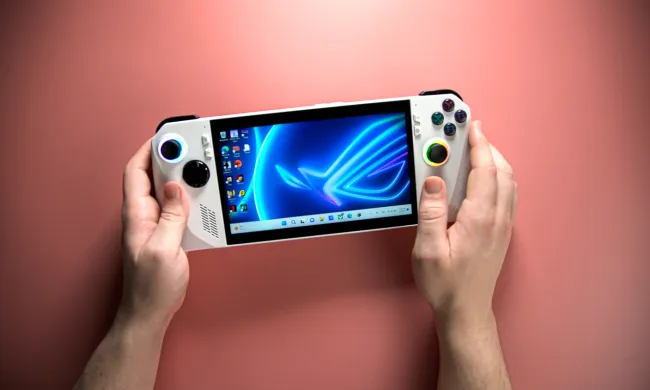Asus is making the ROG Ally better. Although the original ROG Ally is one of the best handheld gaming PCs you can buy, the new ROG Ally X improves on the original design in almost every way. It sports better specs, better ergonomics, a larger battery, and a new black colorway — but Asus is also asking for more money. The ROG Ally X comes in at $800, while you can often find the original for less than $600.
We’ve tested both handhelds extensively, as you can read in our Asus ROG Ally review and Asus ROG Ally X review. The updated ROG Ally X is certainly a better handheld overall, but it struggles to justify its premium over the original design.
Specs
| Asus ROG Ally Z1 Extreme | Asus ROG Ally X | |
| APU | AMD Ryzen Z1 Extreme | AMD Ryzen Z1 Extreme |
| Memory | 16GB LPDDR5-6400 | 24GB LPDDR5-7500 |
| Storage | 512GB Gen 4×4 NVMe SSD, micro SD slot UHS-II | up to 1TB M.2 2280 NVMe PCIe Gen 4 SSD |
| Screen | 7-inch, 1920 x 1080, 120Hz, 500 nits, IPS, 7ms, 10-point touch | No changes |
| Speakers | 2x 1W speakers, Dolby Atmos, and Hi-Res Audio support | No changes |
| Ports | 1x ROG XG Mobile, 1x USB-C (USB 3.2 and DP 1.4 support), 1x 3.5mm audio, 1x micro SD slot | 1x USB-C (USB 3.2 Gen 2 and DP 1.4), 1x USB 4, 1x 3.5mm audio, 1x micro SD slot |
| Battery capacity | 40Wh | 80Wh |
| Dimensions (LxWxH) | 11.04 x 4.38 x 0.84 inches | 11.02 x 4.37 x 0.97 inches |
| Weight | 1.34 pounds (608 grams) | 1.49 pounds (675 grams) |
| Price | $700 | $800 |
| Where to buy |
Although the spec sheet for the ROG Ally X delivers some changes, the heart of the console remains the same — as can be expected from something that Asus itself dubs “not a redesign.” The AMD Ryzen Z1 Extreme APU, with its eight cores, 16 threads, 24MB of cache, and 12 RDNA 3 cores, has proven time and time again that it’s a force to be reckoned with. Of course, if we compare it to the Asus ROG Ally Z1 (not Extreme), it’s a whole different story; but now, with the ROG Ally X in the picture, that model makes even less sense to buy. Asus is also said to have changed the motherboard in the new model.
The major spec changes include a boost to the memory. The ROG Ally X now serves up 24GB of
The new ROG Ally X also doubles battery capacity and expands the SSD, not just up to 1TB but also up to an M.2 2280 variant, meaning that storage upgrades should get significantly easier — and the handheld itself can support up to 8TB of storage. Lastly, Asus heard the outcry of its customers and replaced the ROG XG mobile port with a USB 4 instead. This change lets you use an external GPU if you should wish to, and that’s pulling the ROG Ally X into a whole different category.
Pricing and availability

When the Asus ROG Ally (Z1 Extreme) hit the shelves on June 13, 2023, it was initially priced at $700. The not-so-extreme version followed on September 18, 2023, with a $600 price tag. Since then, both models have gone on sale many times over. While the initial pricing held strong, those sales are the best windows of opportunity for those who want to buy an ROG Ally handheld.
In the wake of the ROG Ally X, Asus has officially dropped the price of the original model. The ROG Ally with the Z1 Extreme now sells for $650, while the model with the base Z1 sells for $500. In both cases, you can often score these handhelds on sale for $100 less, so we recommend waiting to buy until there’s a big sale.
The ROG Ally X is more expensive than both of the original models, and by a significant margin. It sells for $800, not only outpacing the base ROG Ally, but also its main competitor in the form of the Steam Deck OLED. As we’ll dig into below, the ROG Ally X bring some significant improvements over the original ROG Ally. However, you’ll spend upwards of $250 more on the ROG Ally X depending on sales, placing it in a completely different price tier without a significant upgrade to performance.
Design and battery
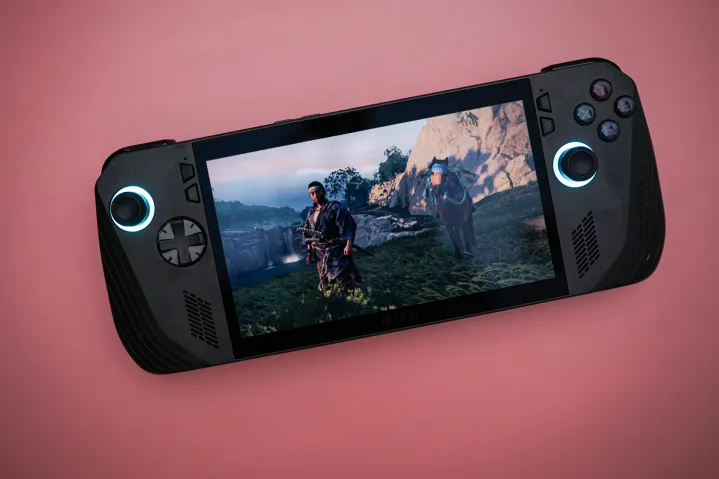
The design shows us that Asus did, indeed, do more than just a slight refresh along the lines of the Steam Deck OLED. The difference is visible at first glance, as the redesigned chassis now comes in black; the other adjustments are more subtle. In the new Asus ROG Ally X, you’ll find slightly deeper handles, a more rounded overall shape, and a slight change to the arrangement of the buttons and the sticks, adding a slant to the triggers to make them easier to use. The macro buttons on the back have gotten smaller, which, as Asus claims, should help you avoid accidental presses.
Asus has also replaced the joysticks on the ROG Ally X with something rated for much higher reliability; Asus promises a 5 million cycle lifespan here. It also improved the D-pad, adding more-precise eight-direction input. There’s also been a change in the placement of rumble motors, and while the speakers stayed the same, the sound chamber got bigger.
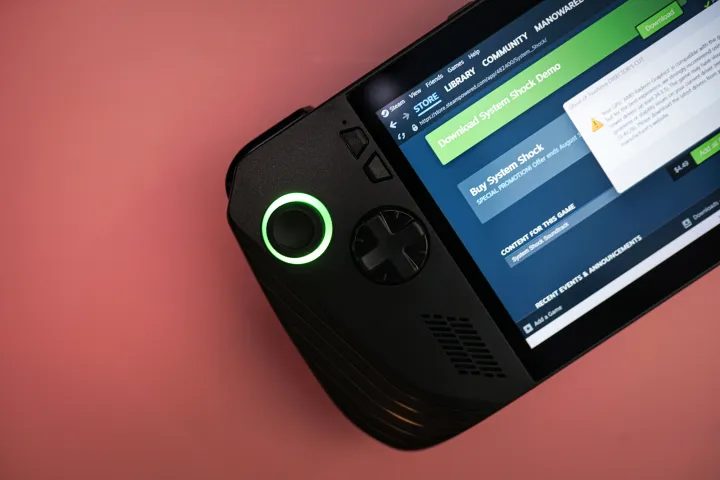
In the hands, the ROG Ally X is more than the sum of its parts, and that’s immediately apparent next to the original model. The base ROG Ally has a weak D-pad, terrible triggers, and loose joysticks. The ROG Ally X addresses these issues point-for-point, with more resistance on the triggers, clicky shoulder buttons, scooped triggers, and a much more useful D-pad. The moment you hold the ROG Ally X in your hands, it becomes clear how far the original model is behind with its feel.
Perhaps the biggest difference between the old model to the updated version lies in the battery life. Asus doubled battery capacity, bringing it up to 80 watt-hours, all the while barely making a dent in the weight of the device, which has gone up to just under 1.5 pounds. You won’t always see double the battery life with the ROG Ally X, but it gets close. The original ROG Ally can die in as little as an hour with a full 30 watts and a demanding game like Cyberpunk 2077. The ROG Ally X lives more in the range of an hour and a half to two hours, which brings it more in line with the Steam Deck OLED.
Adding things like battery capacity, a larger SSD, and more memory would have meant that the handheld should’ve gotten bigger — but that isn’t really the case. The ROG Ally X is 11% heavier than the original, but that only accounts for an extra 67 grams. It’s also slightly larger, but Asus distributes the extra size in a way that actually makes the ROG Ally X more comfortable than the original. There’s a 4.5mm bump on the handles. With that subtle change, you feel like you can hold the ROG Ally X in your fingers. The original model rests between the pressure of your palms.

To keep the weight similar, Asus had to swap out the fans for new ones that are 23% smaller than those in the ROG Ally Z1 Extreme. However, through the use of 50% thinner fan blades, Asus still promises to deliver improved airflow. Another design change lies in the use of new tunnels that direct air up and out toward an extra exhaust vent, which, according to Asus, should provide 24% more air volume both to the internals and to the touchscreen, lowering temps by up to 6 degrees Celsius.
In our in time with the ROG Ally X, it’s clear Asus did some work on the thermals. The device doesn’t get nearly as loud as it did previously, even under a full load. Temperatures themselves haven’t changed much, however — when pushing a demanding games like Cyberpunk 2077, the ROG Ally X still gets quite hot.
Performance
The ROG Ally and ROG Ally X pack the same Ryzen Z1 Extreme chip, so the performance is largely similar. The ROG Ally X enjoys faster LPDDR5 memory, but more importantly, it comes with 24GB compared to the ROG Ally’s 16GB. Given that memory is shared between the GPU and CPU, the ROG Ally X allows you to give the GPU a full 8GB of memory while still leaving 16GB of memory for the rest of the system. The original ROG Ally needs to compromise when 8GB of memory is allocated to the GPU.
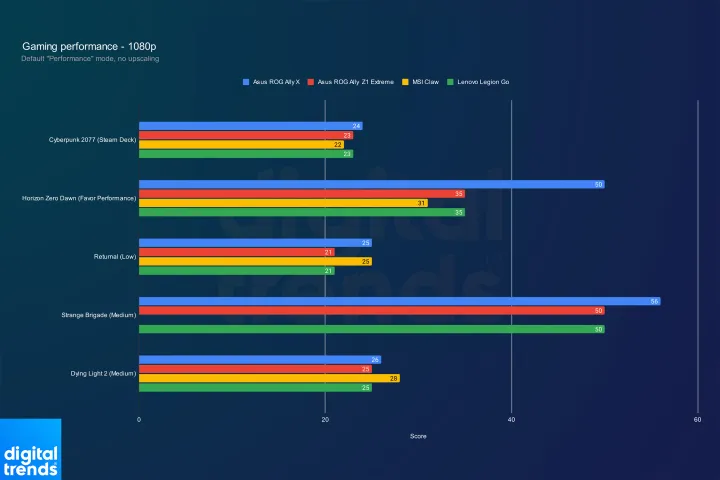
Make no mistake, the ROG Ally X is faster than the original ROG Ally. The difference just isn’t always significant. You can see in the chart above that the ROG Ally and ROG Ally X provide basically identical performance in Dying Light 2 and Cyberpunk 2077. Some games, such as Strange Brigade and Horizon Zero Dawn, appreciate the extra memory, however. In most games, the two devices perform at the same level. In games that are hungry for the extra memory, however, the ROG Ally X can shoot ahead.
Both the ROG Ally and ROG Ally X can operate between 9 watts and 30W, but Asus has slightly different power modes for each device. Here’s how that breaks down:
- Silent: 9W for ROG Ally, 13W for ROG Ally X
- Performance: 15W for ROG Ally, 17W for ROG Ally X
- Turbo: 25W for ROG Ally and ROG Ally X
- Turbo/Plugged In: 30W for ROG Ally and ROG Ally X
Both devices allow you to manually set your power profile, but the tuning for the default profiles is definitely better on the ROG Ally X out of the box. You can see how the different power modes affect performance in the chart below. Performance, Turbo, and plugged in are all grouped tightly together, while Silent is much slower. However, Silent is still a good option for less demanding 2D games where battery life is paramount.

The Silent mode on the ROG Ally X is definitely more useful out of the box, and my chart with the original ROG Ally (below) showcases why. It’s much too slow to be useful in the vast majority of games. There’s also a much wider gap between Performance and Turbo mode, sometimes pushing it to the higher power mode when it’s not needed. Again, you can tweak either device with a manual power mode, but the ROG Ally X is tuned a bit better out of the box.
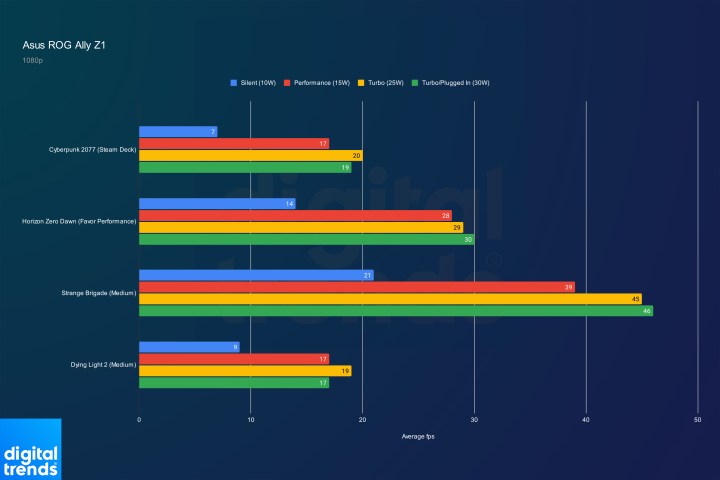
When talking raw performance, the ROG Ally X wins, hands down. There’s some nuance to the conversation here, though. The ROG Ally X hangs its higher pricing on the back of better overall build quality, a much larger battery, and more storage. Performance improvements are a nice upside, but they aren’t the main reason to spend more on the ROG Ally X. In many titles, the ROG Ally and ROG Ally X will perform identically, and the original ROG Ally is much cheaper.
Software

Both the ROG Ally and ROG Ally X run Windows 11 with Asus’ Armoury Crate SE utility.
Asus has massively improved Armoury Crate SE since the the launch of the original ROG Ally, however. Thankfully, those are improvements that both the ROG Ally and ROG Ally X enjoy. For starters, the latest Armoury Crate SE is significantly faster. After logging into
There are several new features, too. You can access AMD’s Fluid Motion Frames (AFMF) directly from the Armoury Crate overlay now, and you can share controller profiles with other users. Asus also redesigned the library page, giving you far more control over how your games appear. The big deal here is that Asus isn’t gating software to the more expensive ROG Ally X, giving owners of the original ROG Ally the same improvements in the software experience.
Better, but by how much?

True to Asus’ word, the ROG Ally X is an improvement over the original ROG Ally in just about every area. The improvements here are collective, however, not individual. There are minor advantages, from a slightly more comfortable build to occasional performance improvements, that add up to make it the better device overall. If there’s anywhere that the ROG Ally X clearly leads, it’s battery life, but that’s not a high bar to clear considering the lackluster battery life of the original model.
If Asus had released the ROG Ally X at $700 — the original list price of the ROG Ally — it would be a slam dunk. That’s not the case. At $800, the ROG Ally X is at least $150 more expensive than the ROG Ally, and often closer to $250 more expensive with how much the original ROG Ally goes on sale. At the moment, with upward of $250 separating the two, the original ROG Ally provides much more bang for your buck.
That will likely change as both devices start seeing sales and open-box units make the rounds. The question then becomes how much extra the ROG Ally X is worth. Based on our time with the devices, the ROG Ally X is worth about $100 more than the original ROG Ally, with $150 being the absolute maximum.




